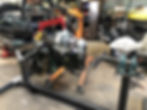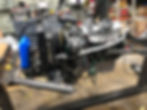1973 Citroen DS Engine Detectives
- Frank Oles
- Aug 29, 2024
- 3 min read

Purchasing a vehicle sight unseen is always a risky proposition. For the most part, we have had very good luck. With this DS, we were in for an uphill battle. Pre purchase, we asked a lot of questions based on our knowledge of Citroen automobiles. And we asked for some very specific pictures. This car had recently had a full engine rebuild, and it came with a stack of receipts from MARRS Automotive (a Citroen specialist on the West Coast) totaling almost 25K! Everything seemed to be in order. However, the moment the car was pulled off the transport trailer, the oil pressure light was glowing red like Rudolph's nose on Christmas Eve - it's a rather prominent feature on the dashboard of this Citroen and very hard to miss. The seller finally admitted "yes, that light had flickered at idle - maybe just try putting a heavier weight oil in." Complete bullshit from an unscrupulous seller. Not wanting to risk engine damage, Jim made the call to pull the engine out and investigate. A real bummer for a new (to us) and quite expensive car.

At least the engine bay of the car was quite fresh and tidy. When confronted with a daunting task ahead, you need to look at the bright side of the situation! Most older Citroens have covered themselves in a protective layer of hydraulic fluid after a few thousand miles.

Step one: spare tire, battery and radiator removed. Looking good so far

Engine and transmission are extracted together as a unit. The engine bay is tight, but we had the engine out in an afternoon. The hard part, diagnosing the actual oil pressure issue, lies ahead.

Empty engine bay. Thankfully, no rust or frame issues to be seen. A very tidy car underneath.

With the engine extracted, we needed to find some way to mount the engine on a stand so that it could be run outside of the car to determine where the oil pressure was going. Jim decided to fabricate his own rotisserie engine stand.

Jim got to work fabricating a sturdy stand that could rotate. You can see the large bearings that support the cradle for the engine here.

The fabrication of the engine cradle was a delicate operation. The components had to be sturdy enough to support the weight of the engine and transmission.

Here is the engine placed on the completed engine stand, with the radiator hooked up and the engine ready to run. An accurate oil pressure gauge helped with the detective work.

Initially, the oil pump and its tolerances were suspect. However, after measuring the tolerances of the pump in the engine against other DS oil pumps, it was determined that the oil pump was not the issue. So Jim rigged up an external oil pump and reservoir that could pressure feed oil to the engine through the main gallery. Thankfully, the cause of the low oil pressure became obvious once the oil pan was removed. Oil was gushing out of the connecting rod/piston assembly.

The bearing on the left is a correct bearing for a DS connecting rod. The bearing on the right has a groove that should only be present on the crankshaft, NOT the connecting rod. This is the bearing we pulled out of the engine - the incorrect bearing! This engine feeds oil pressure through that tiny hole, up through the connecting rod to the wrist pin - it is just a tiny squirt of oil when that hole aligns with a hole in the crankshaft. With the large groove on the right, our engine was seeing pressure fed oil for 180 degrees of rotation - WAY too much oil. The part number on these incorrect bearings cross referenced with an Iveco truck engine. We were able to source the correct rod bearings from a supplier in Europe. It was about a month of sleuthing and waiting for parts to figure this out.

After inspecting the crankshaft, it was determined that, thankfully, no damage had been done to the crank or connecting rod assemblies. After installing the correct bearings, Jim and Stanley were able to test run the engine on the rotisserie and determine that sufficient oil pressure at idle was restored.

While putting the engine back in the car, we encountered a few other issues with a hard pipe in the cooling system that was leaking. After waiting for a few more parts, we were finally able to drive this car and enjoy it with confidence the engine was performing as it should.

Mechanical functions restored, we were finally able to bask in the beautiful design of the DS Convertible. It is a smooth-riding cruiser that adds a bit of French flair to whatever car show we happen to attend.
